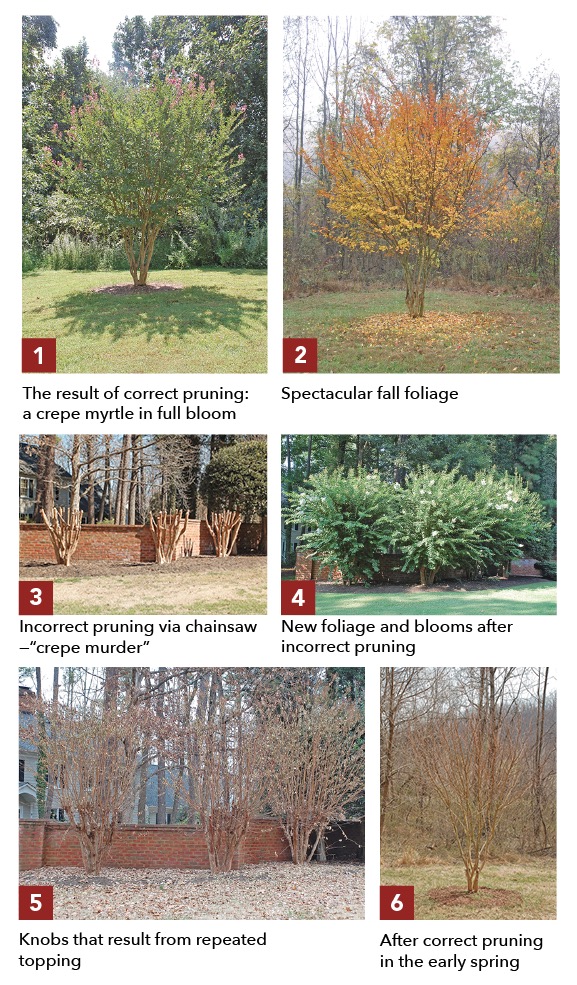Proper pruning will preserve your crepe myrtles’ pulchritude.
By George Sanborn
Crepe myrtles are one of the most attractive landscape trees in the Piedmont (Figure 1). Although native to China and Korea, their drought resistance, attractive foliage, and large blooms that can last up to 100 days make them a very desirable landscape tree in the southeastern U.S. Crepe myrtles vary in size from miniatures to trees that grow up to 30 feet tall. The blooms range in color from white, pink, and red to lavender; no matter what the variety, all of them do best in full sun. The bark is also attractive; strips peel off in the summer to show new mottled bark underneath, only to form new bark and peel again the next summer. In the fall, the leaves turn before falling, and depending on the year, that color can range from spectacular hues of vivid yellow to bright orange (Figure 2).
Unfortunately, though, crepe myrtles are often pruned incorrectly. In my neighborhood, one of the sounds you hear in late winter is the sound of a chain saw. If you go looking for the source of the sound, you will often find someone across the road on a ladder whacking the top out of a line of crepe myrtles (Figure 3). Essentially, the person is topping these trees, or cutting off all the upper limbs – this drastic, and unnecessary, pruning is often called “crepe murder.” Why are they doing this? Does it have to be done? Is it something people do simply because they see their neighbor doing it?
There may be two reasons why people top a crepe myrtle. One is that they think that the large clusters of flowers that emerge from the end of the quick growing shoots of the tree are attractive (Figure 4). I also used to think that the this new growth was attractive, but after attending a Master Gardener course sponsored by the Virginia Cooperative Extension of Virginia Tech, I learned how destructive and unnecessary this pruning is. This unneeded type of pruning is similar to topping a mature tree, or over-pruning a palm tree in the southern and coastal U.S. The foliage and blooms that result from topping are attractive, but they occur at the expense of long term damage to the plant that can reduce its life, not to mention disfigure the tree by destroying its natural shape. The larger blooms are short-lived and grow on thinner and therefore weaker branches. These branches droop, particularly after a rain. The large blooms prevent the tree from developing larger number of smaller flower clusters that will bloom longer.
The new growth is also too dense to allow good air movement and sunlight to reach the branches inside. The lack of sunlight and poor air circulation make the tree susceptible to disease and insects, especially aphids. This stress can cause the plant to produce suckers at the base of the trunk. If allowed to continue growing, these suckers not only form unattractive stems at the base of the trunk, but also require the tree to put some of its resources into the base of the tree rather than devote its full resources to the canopy. Trees pruned correctly will have an attractive appearance even after the leaves fall (Figure 6). On the other hand, trees that are repeatedly pruned incorrectly, will have unattractive knobs that persist until the new leaves come out the following spring (Figure 5).
The second reason people may top a crepe myrtle is to prevent the tree from growing larger and to keep it contained within a certain space. Depending on the variety, mature crepe myrtles can grow to large trees, and therefore it is far better to buy a smaller variety that is suited to the space where it will be planted than to top it every year.
Crepe myrtles usually require minimal pruning in late winter before the new growth starts (Figure 6). The goal is to create a canopy where air circulates freely and allows sunlight to reach the inner branches. Remove any dead branches, branches that are crossing, or branches that are rubbing against each other. Pull off suckers as they develop. Figures 1 and 6 show proper pruning and the result. If it is possible to reach the blooms, remove the old blooms as they start to fade; this may cause a second blooming to occur.
If your crepe myrtle has been disfigured by topping there are ways to bring it back to an attractive, healthy tree. The first is to select the strongest two or three branches from each stump as they start to develop in the spring and remove the other branches. The remaining branches will be stronger and over several years will develop a normal healthy canopy. The second way to restore the normal shape of the tree is cut it back to several inches from the ground before growth starts in the spring. When growth does start select the strongest three or four shoots and remove the others. Over several years remove any other new branches as they develop.
Crepe myrtles are an attractive and desirable, if not native, part of the Piedmont landscape. Proper care will ensure that your crepe myrtle remains healthy and attractive for years to come.
Certified Master Gardener George Sanborn turned from medicine and teaching to the beauty of Virginia, and in particular the Piedmont, after years of living out-of-state for the military and specialized medical training. Now semi-retired, he lives in Madison County adjoining the Shenandoah National Park near Old Rag Mountain. He is certified through the Virginia Cooperative Extension of Virginia Tech.

Good to know more about crepe myrtles!